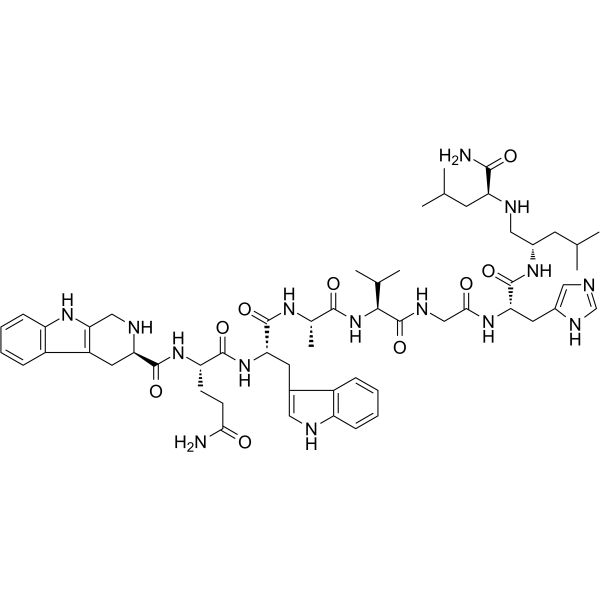RC-3095

RC-3095 structure
|
Common Name | RC-3095 | ||
|---|---|---|---|---|
| CAS Number | 138147-78-1 | Molecular Weight | 1106.322 | |
| Density | 1.3±0.1 g/cm3 | Boiling Point | 1547.9±65.0 °C at 760 mmHg | |
| Molecular Formula | C56H79N15O9 | Melting Point | N/A | |
| MSDS | USA | Flash Point | 889.9±34.3 °C | |
|
The role of central gastrin-releasing peptide and neuromedin B receptors in the modulation of scratching behavior in rats.
J. Pharmacol. Exp. Ther. 337(3) , 822-9, (2011) Bombesin is a pruritogenic agent that causes intense itch-scratching activity in rodents. Bombesin has high affinity for the gastrin-releasing peptide (GRP) receptor (GRPr) and the neuromedin B (NMB) receptor (NMBr). The aim of this study was to investigate p... |
|
|
Facilitation of the inhibitory transmission by gastrin-releasing peptide in the anterior cingulate cortex.
Mol. Pain 6 , 52, (2010) Gastrin-releasing peptide (GRP) has been proposed as a peptidergic molecule for behavioral fear and itching. Immunohistochemistry and in situ hybridization studies have shown that GRP and GRP receptor are widely distributed in forebrain areas. Less informatio... |
|
|
New agonist- and antagonist-based treatment approaches for advanced prostate cancer.
J. Int. Med. Res. 40(4) , 1217-26, (2012) Increased understanding of prostate cancer biology has led to new treatment strategies and promising new agents for treating prostate cancer, in particular peptide-based agonists and antagonists. In this review article, new therapy modalities and potential ap... |
|
|
Investigation of gastrin-releasing peptide as a mediator for 5'-guanidinonaltrindole-induced compulsive scratching in mice.
Peptides 32(2) , 286-92, (2011) Gastrin-releasing peptide (GRP) has been implicated in the itch-scratch cycle. We investigated if this gut-brain-skin peptide plays a role in the compulsive, hindleg scratching of the neck of mice by 5'-guanidinonaltrindole (GNTI), the kappa opioid receptor a... |
|
|
Effects of an antagonist of the gastrin-releasing peptide receptor in an animal model of uveitis.
Invest. Ophthalmol. Vis. Sci. 50(11) , 5300-3, (2009) Some studies have shown the role of gastrin-releasing peptide (GRP) on the production and release of cytokines both in animal models and in humans with inflammatory diseases, but there are no reports on the effects of GRP in ocular inflammatory disease, mainl... |
|
|
Effects of a gastrin-releasing peptide receptor antagonist on D-amphetamine-induced oxidative stress in the rat brain.
J. Neural Transm. Gen. Sect. 117(3) , 309-16, (2010) Previous studies have suggested that bipolar disorder may be associated with oxidative stress. Administration of D: -amphetamine (AMPH) has been put forward as an animal model of mania, and has shown to increase oxidative stress parameters in the rat brain. T... |
|
|
Regulation of HER expression and transactivation in human prostate cancer cells by a targeted cytotoxic bombesin analog (AN-215) and a bombesin antagonist (RC-3095).
Int. J. Cancer 127(8) , 1813-22, (2010) Bombesin (BN) and gastrin-releasing peptide (GRP) have been shown to stimulate the growth of human prostate cancer in vivo and in vitro by mechanisms initiated by binding of the peptide to BN/GRP receptor (GRPR). GRPR is overexpressed in a variety of human ca... |
|
|
Neonatal gastrin-releasing peptide receptor blockade reduces maternal odor preference in rats.
Behav. Brain Res. 214(2) , 456-9, (2010) Alterations in attachment behavior might play a role in the dysfunction in social behavior displayed by autistic infants. Here we show that neonatal gastrin-releasing peptide receptor (GRPR) blockade induces a reduction in maternal odor preference, a task inv... |
|
|
Effect of a gastrin-releasing peptide receptor antagonist and a proton pump inhibitor association in an animal model of gastritis.
Peptides 30(8) , 1460-5, (2009) It has been proposed that reactive oxygen species play a causative role of gastric mucosal damage induced by increased gastric secretion. Gastrin-releasing peptide is a typical neuropeptide that stimulates acid secretion by release of gastrin. In the present ... |
|
|
Effects of N-acetylcysteine/deferoxamine, taurine and RC-3095 on respiratory chain complexes and creatine kinase activities in rat brain after sepsis.
Neurochem. Res. 35(4) , 515-21, (2010) The pathogenesis of sepsis is characterized by an overwhelming systemic inflammatory response that can lead to multiple organ failure. Considering that we have recently demonstrated that mitochondrial respiratory chain and creatine kinase (CK) are altered in ... |